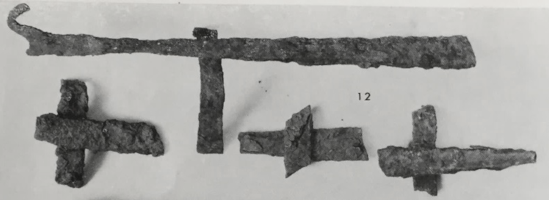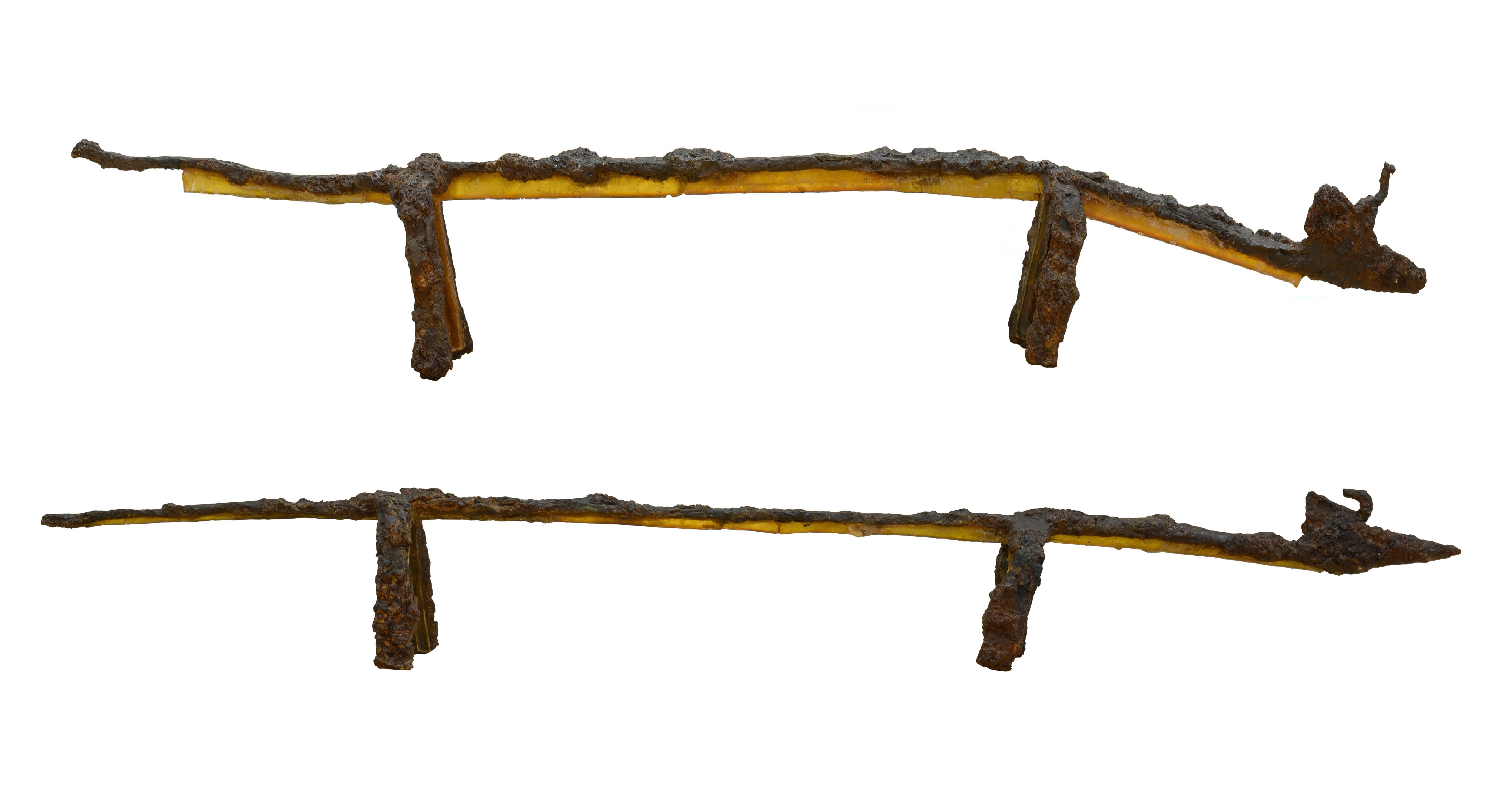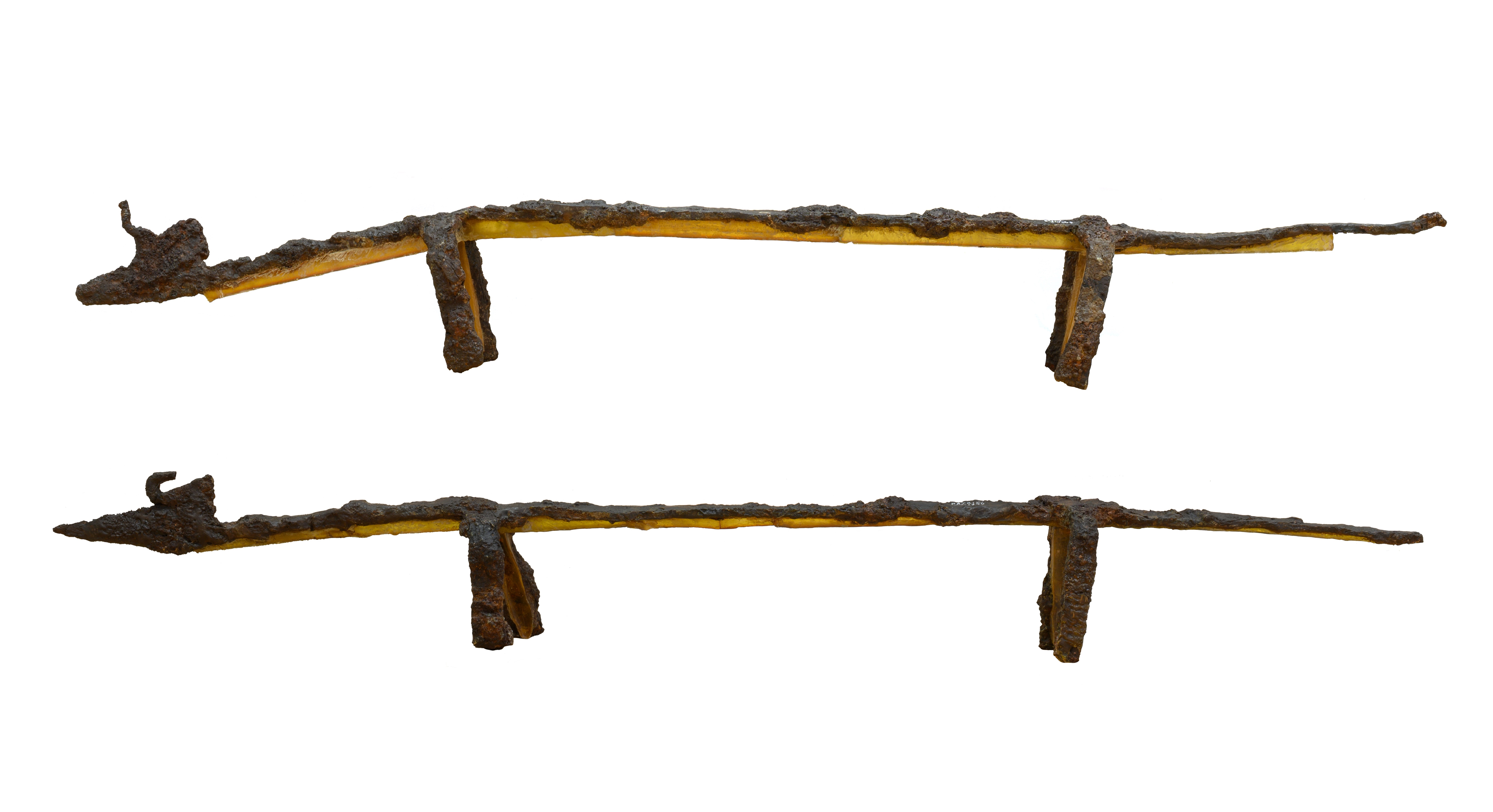The stempost is vertical, ending in an S-shaped horn device that curves forward then backwards parallel to the hull. The ram is integrated. The sternpost is missing except for the base which begins to curve upward. The shape is thus very similar to the previous examples.
Ship-shaped iron fire-dogs
C98
Second half of 8th century B.C. (CG IIIB/CA I initial stage)
Salamis, tomb 79
127: L: 110 cm; H: 12 cm; 128: L: 114 cm; H: 12 cm
A pair of iron fire-dogs, each resting on two stands riveted at right angles to the ship's body. The stern terminal well as parts of the post's horn device have been broken off on both firedogs, while no. 127 is also missing part of its bow projection.
Nicosia Museum
Karageorghis 1973: 19, nos. 127-28, pls. LVIII, CCXXXVII:127-128
The so-called royal necropolis of Salamis includes a set of nine built chamber tombs spanning from the 8th to the 6th century. Tomb 79 was reused twice, including during Roman times and has been both disturbed and partially looted. The first two burials are both dated to the CA I period, with only a short time between the two. This is evidenced by the fact that the wood of the chariot, hearse and bed of the first burial was still preserved at the time of the second one since it was possible to wheel chariot B to a corner of the dromos to make room for the new chariot. Tomb 79 is considered by far as the richest tomb of this period found on Cyprus. In preparation for the tomb, a large foundation ditch was carved out of the soft rock (7.6 m wide and 8 m long). The blocks of the chamber were placed centrally within it, with larger unhewn blocks of varying sizes placed around the sides and fixed with gypsum. The tomb consists of a rectangular chamber (3.2 m east-west and 2.4 m north-south) facing east, with a monumental façade (12.8 m wide) of well hewn ashlar blocks forming a ?-shaped recess, a paved forecourt, and a large dromos covered with a layer of concrete. The stomion (1 m wide, 1.55 m high) is in the east wall of the chamber, north of the central axis (1.5 m high, 1 m wide) with no threshold, the floor of the chamber being on the same level as the propylaeum. The dromos is sloping and 16.8 m long, its two sidewalls built of regular ashlar blocks. As for the other Salaminian built tombs, tomb 79 is characterized by a small burial chamber and a long, wide and massive dromos filled with grave goods. This excessively large dromos and an undersized burial chamber emphasize the importance of public funerary display. Offerings within the dromos thus appear to flaunt wealth before a funeral audience. The fact that the floors of the propylaeum were paved and dressed with ashlar façade walls suggests an interest in creating an area of focus. The wide ramped entryway meanwhile allowed the funeral procession to lead vehicles down to the tomb's doorway. The possibility of large-scale feasting and drinking is supported by over 150 bowls and dishes of various sizes, some containing chicken and fish bones or eggshells. The presence of coarse wares and cooking pots further supports the theory of food preparation at the tomb.
The first burial was given a four-horse chariot (chariot B) and a hearse (?), no longer in situ. Originally, the chariot was placed in front of the chamber near the central part of the propylaeum. A large number of bronzes belonging to the horses and chariots of this initial burial were amassed and piled up in the north-west corner of the propylaeum. These include bronze accessories for the yokes of chariots, breast-plates, front bands, blinkers, horse bits, two bronze tire discs decorated in repoussé with a winged lion striding over a fallen enemy, large caps in the shape of a sphinx for each end of the axle, and a bronze figurine of a soldier at the top of the linchpin. At the back of the chariot box is a bronze loop for fastening a shield. The hearse on which the coffin was placed for transportation to the tomb is most elaborate of those found at Salamis. Its bottom is decorated all around with five bronze lion heads, highlighting its ceremonial character much like the chariot itself. The chariot of the second burial was found in situ and was likewise elaborately decorated. Along the north wall of the propylaeum were also two bronze cauldrons, one of them complete with a tripod and decorated with griffin protomes and four bearded mermen. The second cauldron has a high pedestal and is decorated with griffins and plaques engraved with Hathoric heads. In this location were also uncovered the pair of ship-shaped iron fire-dogs and the bundle of twelve iron obeloi with rectangular sections and a tubular slit socket, occasionally with traces of wood preserved. The burial also came with an impressive array of furniture of Phoenician workmanship, including a bed, three "thrones" and two accompanying footstools. These were elaborately decorated with ivory plaques, silver and gold sheet, and blue paste inlays. Pieces of warrior equipment include a bronze spear, a boss shield, and two ivory toggles probably belonging to swords.
Karageorghis, V. 1973-74. Salamis V. Excavations in the Necropolis of Salamis. Vol. III. Nicosia: Department of Antiquities, Cyprus.










